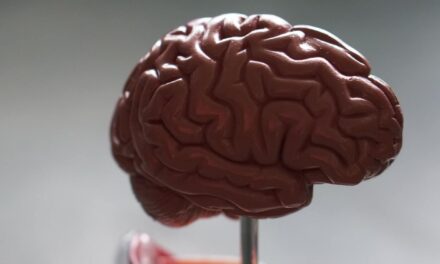Supervised by: Graham Reid, MSc. Graham studied Psychology and Neuroscience at both undergraduate and master’s level and he is now completing a PhD at the University of Oxford in Psychiatry. He is fascinated by human behaviour, thinking, and feeling. His particular area of intertest is in how our brains and behaviour changes as we age, including diseases such as dementia.
Abstract
This article reviews the role that Emotional Intelligence (EI) plays in stress management in students and EI’s influence on students’ overall academic performance. We explore the function of EI in managing internal pressures, such as dealing with the fear of failure and maintaining self-motivation in times of acute stress. Equally as influential, we analyze EI’s contribution to managing external pressures such as self-fulfilling prophecies and interpersonal relationships. In addition, this article explores the relationship between EI and neurodivergent individuals, investigating the effect it has on their brain functionality. Although previous research has focused on the link between EI and academic performance, this association is still heavily doubted and debated. Nevertheless, the field of EI is continuously expanding, and the significance of EI in the moderation of anxiety and stress is paramount in an increasingly competitive and global academic community.
1. Introduction
Approximately 61% of teenagers undergo stressful experiences while concurrently possessing a strong desire to excel in their academic pursuits. In this context, EI emerges as an essential factor that enables a student to become more self-aware by becoming increasingly conscious of their emotions, actions, and thoughts concerning stress. Through investigating these dynamics, we seek to gain a comprehensive understanding of how EI influences students’ ability to mitigate and cope effectively with stress, thereby enhancing their overall academic performance. Our research aims to uncover valuable insights that can shed light on the critical learning needs of students and identify potential societal implications and solutions in today’s complex educational landscape.
1.1 Definition of Emotional Intelligence
EI is defined as the capability to understand, interpret, and be aware of an individual’s emotions. It includes the ability to recognise, express, reason with, and generate emotions effectively. EI has often been described as a trait (a characteristic of an individual), skill (an action done successfully), or a mix, and as a result, copious measures and models of EI exist. The three main models are a performance-based ability model, a trait-based model, and a self-reported mixed model. Salovey and Mayer (1990) developed the ability model, which describes EI as an innate form of intelligence that includes a person’s ability to perceive and manage emotions. Subsequently, the measures were performance-based tests. Contradicting, Petrides and Furnham (2001) perceived EI to be an attribute of one’s personality rather than a skill and developed the trait-based model of EI. Combining both these views, Bar-On (1997) developed a mixed model which measures EI as a set of ‘non-cognitive’ competencies such as adaptation skills, intra- and inter-personal skills, and adaptability. The very existence of EI and the literature surrounding it is heavily debated, with each model having its own set of advantages and disadvantages. However EI is classified, EI plays a significant part in managing the various stressors engendered in an educational environment.
1.2 Definition of Anxiety
Anxiety is an emotional response to perceived threats or stressful situations and can be reflected by often irrational and constant worrying thoughts. It is described by feelings of unease, worry, or fear. Although experiencing anxiety on occasion is normal, anxiety becomes concerning when it proceeds to be persistent and excessive. Ordinarily, anxiety triggers the onset of the sympathetic nervous system and results in physiological symptoms such as increased heart rates and blood pressure, dilated pupils and excessive sweating. Anxiety also includes complex cognitive changes and influences an individual’s thinking patterns.
1.3 Definition of Academic Performance
According to Shirazi and Heiradi (2019), academic achievement is the extent to which students accomplish fixed educational aspirations and targets. Multiple indicators of academic achievement exist worldwide, such as GPA scores, A-level results, graduation rates, and SAT scores. The bulk of our paper will utilize average scores such as GPA.
1.4 Overview
This paper will focus on the profound impact that EI has on stress management among students, particularly concerning the stressors arising from the fear of failure, self-motivation, academic pressure, and maintaining interpersonal connections in a competitive environment. These specific aspects were chosen as they highlight the larger and more significant stressors that EI has had an impact upon.
2. Fear of Failure
Perceptions of failure play a key component in stress management; a healthy stance towards failure, which is associated with higher levels of EI, promotes problem-focused coping and prevents the excessive use of emotion-focused coping. While both emotional and problem-focused coping are essential, it is not healthy to have either overly relied on. Emotion-focused coping does not tackle an issue directly and instead focuses on managing the emotional response to a stressor; on the other hand, problem-focused coping refers to tackling a stressor directly. In a study by Tao, Li, and Wu (2022), students in an economically disadvantaged area of China were randomly allocated into two groups: one attended classes on growth mindset, and the other attended general mental health classes. The fundamental teaching of the growth mindset is not to fear failure but to value its essential role in the learning process and persist through – or even seek – challenges. As the area participants lived in was economically disadvantaged, societal pressure enforced a fixed mindset on the students in the context of academics and careers. Those taught the growth mindset developed stronger problem-focused coping abilities and tackled academic issues with more effort. Figure 1 provides a visual of the relationship between the growth mindset (referred to as the incremental intelligence mindset), fear of failure, problem-focused coping, and emotion-focused coping. When students reduced their fear of failure, a potentially more critical skill for individuals in groups that society expects to fail, coping methods for academic stress became better balanced. While some emotion-focused coping is essential, a study by Wang and Fredricks (2013) shows that the excessive deflection of challenges – a manifestation of excessive emotion-focused coping – is correlated with higher rates of depression and delinquency in students. In conclusion, views of failure promoted by the growth mindset and higher levels of EI encourage problem-focused coping, as opposed to excessive emotion-focused coping with potentially harmful effects. While one’s stance on fear of failure plays a pivotal role in choosing the best stress management strategy, so does self-awareness.
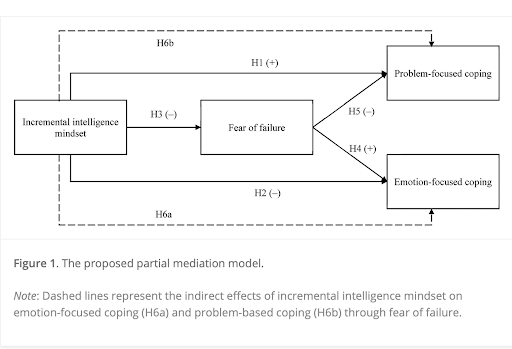
Figure 1: From “Incremental Intelligence Mindset, Fear of Failure, and Academic Coping” by V. Tao V, Li Y, Wu A. 2022, Journal of Pacific Rim Psychology. Copyright 2023 by Beijing Normal University.
3. Self-Awareness of Stress Management and Self-Motivation
EI develops self-awareness, allowing individuals to identify their emotions, select appropriate coping strategies and motivate themselves. According to ideas of self-determinism, feelings of autonomy and awareness of intrinsic values lead to motivation. A study by Simos and colleagues (2019), in which participants were obese, approached mitigation of the habit of emotional eating by emphasizing that it is an unhealthy coping mechanism for stress. All participants underwent a weight loss program. The experimental group simultaneously took a course that taught stress management through self-awareness, called Pythagorean Self-Awareness Intervention (PSAI). PSAI involves recalling daily actions (sleep, diet, exercise), introspection regarding how beneficial or harmful events of the day were to oneself, and acknowledgment of absent habits that could be beneficial. Compared to the control group, participants in the PSAI condition had a more significant reduction in emotional eating behavior, perceived stress, and BMI. The experimental group had greater success because the PSAI required self-awareness of what strategies benefited them and their goals. Participants used self-awareness to identify methods to mitigate binge eating and establish motivation by organizing a strategy to reach goals. Adversely, how self-awareness impacts an academic environment can be seen by observing students with Alexithymia in a study by Ferena, Pepe, Ornaghi, and Cavioni (2021). Alexithymia is a disorder characterized by the inability to recognise and articulate, or the self-unawareness, one’s own emotions. Students with Alexithymia were found to be less capable of identifying their stressors, leading to prolonged exposure to academic stressors and a greater likelihood of burnout. Emotional intelligence, which enhances the skill of self-awareness, can be used to identify academic stressors and how to cope best. Additionally, the skill of self-awareness, in the sense of being aware of self-fulfilling prophecies, is an element of emotional intelligence and academic success.
4. Self-Fulfilling Prophecy and Emotional Intelligence
Studies have thoroughly examined the relationship between EI and the self-fulfilling prophecy, yet, despite the numerous pieces of evidence, the correlation between the two remains unclear. The self-fulfilling prophecy refers to the phenomenon in which beliefs or expectations, when acted upon, influence behavior to confirm those beliefs. This concept encompasses both self-imposed prophecies and other-imposed prophecies. By examining how individuals with high EI levels utilize self-fulfilling prophecies to enhance academic performance, manage stress, and shape others’ expectations, we can explore EI’s potential impact on academic achievement and stress management.
4.1 Self-Imposed Self-Fulfilling Prophecy
Considering the characteristics associated with individuals high in EI, it can be postulated that they are more likely to set their initial anticipated acceptance at a level that positively influences their outcomes through the self-imposed self-fulfilling prophecy. However, it is important to note that not all individuals with high EI anticipate themselves to be fully positive outcomes and be accepted by others.
4.11 Anticipated Acceptance, Behaviors, and Actual Outcomes
A study conducted by Stinson and colleagues (2009) explored the connection between anticipated acceptance, behaviors, and actual outcomes in situations involving the risk of rejection. The study found that individuals with low anticipated acceptance tend to exhibit inhibited warmth as a protective mechanism against potential rejection. Consequently, this inhibited warmth leads to lower levels of actual acceptance, thereby confirming their initial fears. However, the study also revealed that when social anxieties regarding rejection were alleviated through experimental manipulation, individuals with low anticipated acceptance no longer felt the need for self-protection. Consequently, they were able to exhibit warmer behavior, which increased acceptance from others.
4.12 Application on High Emotional Intelligence
This study highlights the positive impact of reducing anxieties related to rejection on social outcomes. Considering EI, individuals with high EI levels are likely to employ effective coping strategies to reduce their fear of negative social acceptance. As a result, individuals can eliminate the need for self-protective measures, and increase their chances of gaining positive social acceptance influenced by self-imposed self-fulfilling prophecies. This study concludes that individuals with high EI possess the ability to cultivate a positive mindset, resulting in higher social acceptance. This, in turn, has a positive impact on their academic performance as they are more socially accepted and able to comfortably seek assistance in their educational processes.
4.2 Other-Imposed Self-Fulfilling Prophecy
Other-imposed prophecies, including the perceptions and expectations of others, also play a significant role in the self-fulfilling prophecy. One well-known form of other-imposed prophecy is the Pygmalion effect, demonstrated in the influential study conducted by Rosenthal and Jacobsen (1968). The study showcased the impact of high expectations on student performance. Teachers were informed that certain students were likely to experience significant intellectual growth, leading them to treat those students differently. Despite the students initially scoring equally on standardized exams, at the end of the school year, the teacher-believed higher achievers performed better on the retests.
4.21 Teacher Expectations on Academic Outcomes for Emotionally Intelligent Students
The above study revealed the power of others’ expectations in shaping outcomes. Therefore, it is important to note that students with high EI levels are not guaranteed academic success, since this depends on the expectations projected by teachers. If the influence of teachers’ expectations is significant, it can impact students’ academic performance regardless of their EI levels. Self-fulfilling prophecies may also be sustained by the situation. For example, if a teacher has low expectations, it can lead to initial placement in a remedial classroom and trap a student in that level throughout their academic career. (Blau, 2003; Broussard & Joseph 1998; Moller et al., 2006; Oakes, 1995). This implies that emotionally intelligent individuals may still face learning differences and challenges that affect their academic capabilities.
4.22 Factors Influencing Teachers’ Expectations and Effects on Student Performance
In addition, Riley and Ungerleider (2012) reflect teachers’ expectations as the assumptions teachers make regarding students’ potential to perform well academically. These assumptions may be influenced by a number of factors, including a student’s aptitude for academic achievement, IQ test scores, family background, and comments made by former teachers. Ethnicity, as revealed in a study by Clifton and colleagues (1986), also significantly influences normative and cognitive expectations. This emphasizes the idea that emotionally intelligent individuals would not necessarily produce positive outcomes, as many factors are involved with teachers’ expectations.
4.23 Implications for Academic Achievement
From this evidence, the phenomenon of other-imposed self-fulfilling prophecies can significantly generate and impact an individual’s academic performance. In this context, multiple factors can influence teachers’ expectations, and so even individuals with high EI levels may find themselves trapped in a discouraging cycle of negative interactions and repeated failures due to the negative perceptions and interactions projected upon them.
4.24 Actual Effect Size of Self-Fulfilling Prophecy
However, two aspects counter this notion. Firstly, a research study by Smith et al. (1999) found that the effect size of self-fulfilling prophecies may be relatively small, and their presence appears only over time. They discovered that a teacher’s belief regarding a student’s potential could only influence that student for several years after the initial contact. Furthermore, students who were targets of higher expectations in 7th grade took a greater number of non-remedial high school math courses compared to students with lower expectations.
4.25 High EI Levels and Potential to Modify Teachers’ Expectations
Secondly, by highlighting their skills in effective communication, self-awareness, self-regulation, and relationship management, individuals with high EI might be able to gradually change teachers’ perceptions over several years after the initial contact with teachers even when low expectations are initially projected. They can understand their own emotions, strengths/weaknesses, and values, establish and maintain positive relationships, and keep a positive outlook in challenging academic situations, thus reversing the initial expectations teachers had of them. Furthermore, in fact, MacCann and colleagues (2020) suggest that students with emotion management skills are able to learn from negative feedback or boring subject matter, and ultimately improve academic performance.
4.3 Conclusion
In conclusion, the relationship between self-fulfilling prophecy and EI is complex and unclear. While individuals with high EI may employ effective coping strategies to exhibit positive results through self-imposed self-fulfilling prophecies, the impact of other-imposed prophecies, such as teachers’ expectations, cannot be ignored. Factors such as aptitude, prior comments, and cultural biases can influence teachers’ perceptions and ultimately impact academic outcomes. Nevertheless, the effect size of self-fulfilling prophecies may be limited, and individuals with high EI have the potential to challenge and modify teachers’ expectations.
5. Social Competence and Emotional Intelligence
As discussed prior, external factors such as the expectations and perceptions of others can often govern our behavior concerning self-fulfilling prophecies. How one is perceived, as well as interpersonal relations and interactions, can therefore be said to play a direct role in influencing academic achievement (AA). The literature surrounding EI is regularly debated as it is constantly evolving and developing. However, the aspect of EI relevant to the discussion surrounding social competency and EI is being able to decipher and regulate emotional states of oneself and others. (Hogeeven and Salvi, 2016) These emotional capacities are paramount to the development of social competence in students. Social interactions are inherently multidimensional; social contact is not just dependent on emotional capacities but on cognitive processes and the sociocultural background of individuals. Addressing all these aspects, Orpinas and Horne (2006) defined social competence as a person’s capacity to function amiably in his or her environment. The link between EI, social competence, and AA is not completely established. Numerous studies address the distinct links between EI and AA and between social competence and AA. A study by Estrada et al. (2021) finds a link between all these variables as displayed in Figure 2 below. From a sample of 550 respondents from 5 distinct establishments, the study revealed no direct relationship between EI and academic performance. However, there were direct correlations between EI and compassion, and engagement levels in students ensuing significant improvements in AA. To reduce the probability of social desirability bias from the self-reported measure of EI, the participants were ensured anonymity and confidentiality to promote the likelihood of honest answers. Alongside other studies that find positive correlations between the various aspects of social competence and AA, it can be concluded that EI plays a significant role in the development of certain social and cognitive skills that directly influence AA.
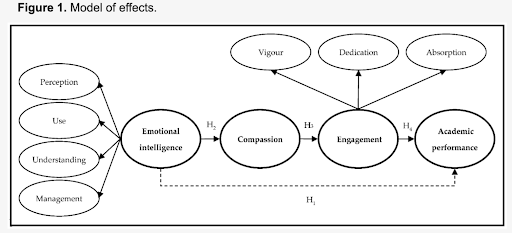
Figure 2: From “Does Emotional Intelligence Influence Academic Performance? The Role of Compassion and Engagement in Education for Sustainable Development,” by M. Estrada et al., 2021, Sustainability, 13 (4), p 7/18.( https://doi.org/10.3390/su13041721 ). In the public domain.
5.1 Development Through Adolescent Years
A vast majority of studies regarding EI and AA, involve university students – with a mean age of 17-24 for undergraduates. In reality, the lexicon ‘student’ can encompass a wider range of ages and levels of education from primary years to secondary years of high school. For the sake of this discussion, the adolescence period between ages 13-19 will be argued to be of critical importance in the development of EI and other social/cognitive processes. Although the period is regularly perceived in a negative light, with Freud (1969) viewing it as a ‘development disturbance’, it is also perceived with optimism through the Positive Youth Development (PYD) outlook by Geldhof et al. (2013). Despite the various approaches, the period of adolescence is universally recognised as a period of change and development both physiologically and psychologically.
5.11 Physiological changes through adolescence
Puberty is described as a transitional period that is of great importance to adolescence. A study by Gunner et al. (2006) investigated the changes that occurred in the activity of the hypothalamus-pituitary-adrenal (HPA) axis and cortisol levels (its primary hormone) during puberty. Cortisol levels and the activity of the HPA axis are proven to be significant in stress regulation and reactivity however changes to this activity during puberty are not well researched. Gunner found that the period between childhood and adolescence is associated with changes in the activity of the HPA axis, with higher basal cortisol levels and stronger reactivity levels. Although the generalisability of the findings can be questioned due to the Eurocentric nature of the sample and the specificity of the task, it still supplies important evidence for the idea that transitions through puberty may inflate adolescents’ sensitivity to stressors (McCormick et al., 2016). Nicole B. Perry further explored the relationship between HPA axis activity in adolescents who experienced early life stress (ELS) to see if it would predict ‘socioemotional adjustments’ in a longitudinal study. One conclusion drawn was that previously institutionalized youth with high cortisol levels had substandard regulation of their emotions and showed more pessimistic reactions than non-adopted youth with high cortisol levels (Perry et al., 2022). Since all these facts influence emotional stability and social competencies, which are veritably important in completing education, it can be surmised that the hormonal and emotional interactions that occur in adolescents are pivotal in their socioemotional skills for education and future careers.
5.12 Psychological changes through adolescence
Adolescents undergo many neurological changes as they develop that have a subsequent impact on levels of emotional sensitivity and social susceptibility. Significant structural changes in the adolescent brain have been found in the regions of gray and white matter. Figure 3 displays the increased volume of white matter and the decreased volume of gray matter (Crone and Konijn, 2018). These regions of the brain are important to aspects of social competence and emotional intelligence, such as recognising mental states and processing social emotions such as shame (Blakemore and Mills, 2014). If the volume of these tissues is changing considerably through adolescence, then it is plausible that emotional and social capacities are still maturing and are more plastic, and thus that one’s environment is especially influential on ‘cognitive control’ and in turn adolescent well-being. Ultimately, neurological and psychological developments that occur in adolescence can be said to be of importance to the development of EI and social competence.
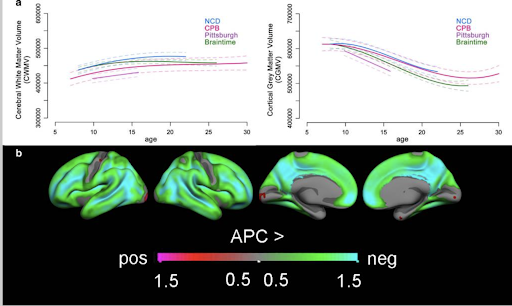
Figure 3: ‘Longitudinal changes in brain structure across adolescence (ages 8–30). a Consistent patterns of change across four independent longitudinal samples (391 participants, 852 scans), with increases in cerebral white matter volume and decreases in cortical grey matter volume (adapted from Mills et al., 2016, NeuroImage105). b Of the two main components of cortical volume, surface area, and thickness, thinning across ages 8 to 25 years is the main contributor to volume reduction across adolescence, here displayed in the Braintime sample (209 participants, 418 scans). Displayed are regional differences in annual percentage change (APC) across the whole brain, the more the color changes in the direction of green to blue, the larger the annual decrease in volume (adapted from Tamnes et al., 2017, J Neuroscience15)’
From “Media use and brain development during adolescence,” by E.A. Crone and colleagues, 2018, Nature Communications, 9, p 2/10. ( https://doi.org/10.1038/s41467-018-03126-x ). In the public domain.
5.2 Managing One’s Emotions
As aforementioned in the section regarding the role of EI in self-motivation, the value of self-awareness in enabling students to recognise their feelings and therefore employ efficient coping strategies is fundamental in stress management and AA. Moreover, concerning interactions with peers, instructors, and family, the ability to decipher and regulate one’s mental state is of cardinal significance. This is highlighted by the reciprocal relationship between stress management and social competence. Social anxiety and a lack of social competence can increase stress levels but lower levels of stress regulation can also increase antisocial behavior. A study by Méndez et al (2019) investigated the relationship between levels of EI and manifestations of bullying in adolescent students. EI was measured through the emotional quotient-youth version (EQ-i: YV) by Bar-On and Parker. It consisted of a 4-point rater scale of 60 items divided into 5 distinct dimensions: interpersonal [INTRA], interpersonal [INTER], stress management [SM], adaptability [ADAPT], and general mood [GM]. Furthermore, the school violence questionnaire measured the perception of the occurrence of certain behaviors, including, but not limited to, verbal violence amongst students, disruptive behavior in classrooms, and physical direct violence amongst students. In a sample of 309 students from the Murcia region in Spain, it was found that for each increase in stress management difficulty, there was a subsequent increase in the perception of physical direct violence. Therefore substantiating the idea that students with deficient emotional abilities such as stress management are more likely to employ ineffective coping strategies, which is reflected in the overall increase of perceived school violence. Furthermore, with each increase in interpersonal and stress management difficulty, students were more likely to perceive disruptive behavior in classrooms. This can be attributed to difficulties in identifying the emotions of themselves and others, and can be linked to an increased prevalence of antisocial behaviors. A study by Obregon-Cuesta et al. (2022) found that students who were bullies or victims of bullying displayed lower average marks than students who were neither bullies nor victims. Aparasi et al. (2021) found that bullies find it harder to organize and coordinate their resources and time for examinations and have lower adaptability levels in university. Ultimately, students’ ability to manage their stress, adapt and interact with others can all be reflected by EI and are shown to directly influence their behavior in school and therefore their overall academic performance. This is highlighted in Figure 4.
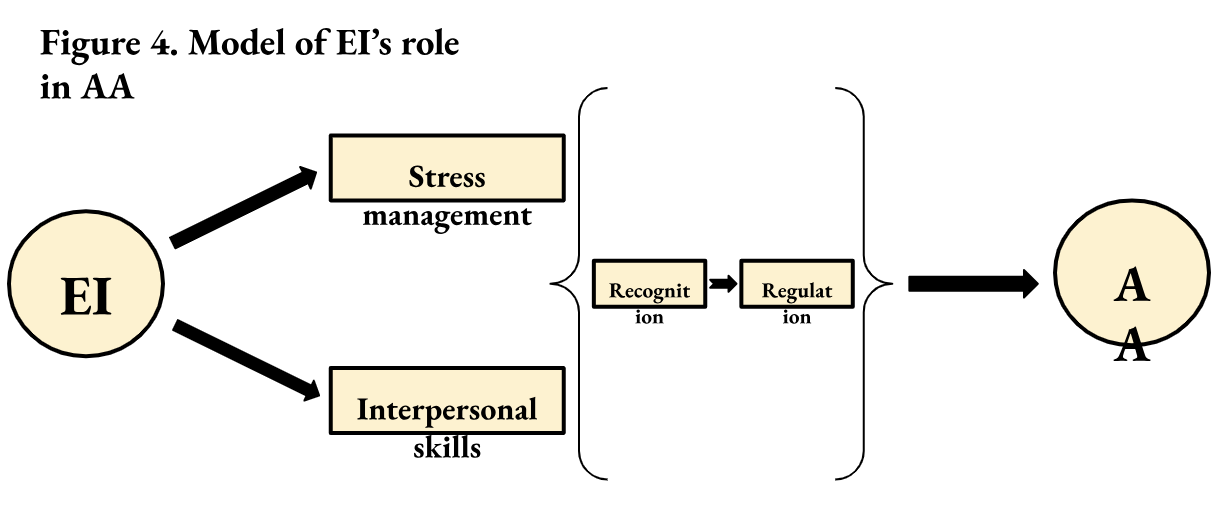
Figure 4: Model of EI’s Role in AA
5.3 Managing Others’ Emotions
The stress and academic pressures that students face can often result in an inability to communicate ideas properly and develop empathy towards others which inevitably leads to a deterioration of social ties with colleagues or instructors. Mavroveli et al. (2007) investigated 3 focal points, one being the correlation between trait EI and ‘peer-rated social competence.’ The EI of 282 Dutch students was measured by the Trait Emotional Intelligence Questionnaire-Adolescent Short Form (TEIQue-ASF). Peer perception of social competency was measured by the Guess Who Peer Assessment, where students were asked to suggest a classmate who best fitted certain behavioral criteria such as cooperation and aggression. Larger positive scores on the peer assessment were reflections of greater social competence. Overall, a positive correlation was found between high trait EI scores and social competence scores, and cooperation. Although a relatively weak correlation, the findings still reveal a positive association between trait EI and perceived social competence. Adolescents with high trait EI are seen to be more cooperative by their peers and are more likely to develop successful and gratifying peer relationships. When exploited, the social skills associated with high trait EI can be applied in persuasion and negotiation skills for future networking and prospective vocational opportunities. Social competence and trait EI are of particular importance for students today in an educational environment that increasingly values small-group learning. Communication like this becomes of particular importance in small-group learning. Edmunds and Brown (2010) found that small group learning develops reflection, collaboration, listening, and discussion skills. Moreover, a lack of social competence can be exhibited by social exclusion and withdrawal, ostracism, and overall peer rejection. Consequently, students may experience loneliness, exhibit antisocial behavior and struggle with psychological disorders such as depression and generalized anxiety disorder. Therefore, there would be an increase in stress levels and a decrease in stress regulation that may be reflected by frequent absenteeism or dropping out of school. Overall, managing others’ emotions as a feature of EI is critical in communication, cooperation, and general social competency as it indirectly affects academic life.
5.4 Socio-Cultural Background
Notwithstanding the relevance of EI, other factors can influence stress management and social competence. A noteworthy environmental factor is a student’s socio-economic background. According to Rahman et al. (2023), Socioeconomic Status (SES) refers to a person’s economic, political, and professional position in society. The SES of a student’s family often influences their access to resources, connections, and opportunities. Furthermore, students of a lower SES are more likely to have limited focus, as a result of working alongside their studies to pay for tuition. Increased stress levels are common in students of lower SES and may hinder their ability to perform to their full potential.
In addition, the racial-ethnic minority status of a student frequently increases the likelihood of peer victimization such as microaggressions. This makes them more vulnerable to school bullying than the ethnic majority eliciting feelings of affliction and frustration which may negatively impact academic motivation (Fu et al., 2021). The influence of bullying on academic achievement was explored before, but the relevance of ethnic status was overlooked. Despite a student’s level of EI, ethnic and socio-economic status are indispensable in the discussion of stress management and academic performance.
5.5 Conclusion
To conclude, EI can be summarized as a student’s ability to identify their emotions, regulate them and use them to manage others’ emotions. Whether a trait or a skill, EI is invaluable in its influence on social competency. A lack of these emotional and social competencies both increases the need for stress regulation and decreases a student’s ability to manage their stress. Though the socio-cultural background of a student can be a relevant factor, the ability to maintain interpersonal relationships and communicate both empathetically and effectively is paramount to the academic success of students.
6. Overall Acamdemic Performance and Emotional Intelligence
6.1 Correlation Between EI and GPA
Emotional intelligence plays a large role in a student’s success and well-being throughout their school career. In general, a student’s scale of emotional intelligence in school depends on their ability to communicate with others, identify and handle their emotions, and overcome stressful situations and challenges. These characteristics serve as crucial factors in any classroom and are expected to be understood by students at a very young age. Although one’s emotional intelligence usually improves with age, it has been observed that there is a significant correlation between EI and increased GPA (Grade-Point Average) among students of any age. In a study performed by Singh et al. (2009), 389 university students were asked to take an adapted version of the Self-Report Emotional Intelligence Test (SREIT), which measures emotional intelligence through 33 emotion-based “agree or disagree” questions. After the test, it was reported that there was a notable positive correlation between EI and GPA, since most of the students who showed a high level of emotional intelligence on the test, also ended up having a high GPA. The high GPA may come from increased and more frequent feelings of positivity (enjoyment, pride, etc.) or the ability to better handle negative emotions (doubt, stress, etc.). The study offered further insight into the topic of emotional intelligence in schools because it offered a connection between grades & the form of intelligence and explained the emotional characteristics one must have, to make good grades more achievable.
6.11 Social Factors of EI
Nonetheless, it is questionable whether GPA is the optimal factor in a study of emotional intelligence. While GPA and emotional intelligence correlate, it is possible that not all students positively support this correlation. For example, a person or student may be incredibly charming, social, and empathetic, but might not be excelling at school, for factors very different than their level of emotional intelligence, such as their home situation, social class, or health. On the other hand, there may be a student who is extremely academically driven and prioritizes their schoolwork, to the point where they may not be very socially or emotionally intelligent. Nonetheless, they may have a high GPA. A third variable, such as the ones listed above, can largely impact and alter the correlation. For example, high GPAs can come from more than just a high EI level. A supportive home environment, as well as the economic ability to afford extra programs to support a student, will almost certainly boost their GPA. On the other hand, if a student has a rather toxic family and not a lot of money, they may not be given the same chance to succeed as the student with a happier life. Lastly, while some students may potentially have a high EI, and hence a high GPA, there may be other factors that serve as a priority over school. Health, for example, is a factor that may stand in the way of good grades. Most people prioritize their health and well-being over their intelligence, meaning that, if their health is at risk, they will choose to ignore schoolwork and focus more on their physical well-being. In addition, if a student is frequently pulled out of school for medical care, it can influence their ability to keep up with work, as well as fit in, in a school environment. Overall, however, there seems to be an impressive connection between one’s level of emotional intelligence and their academic performance and achievements.
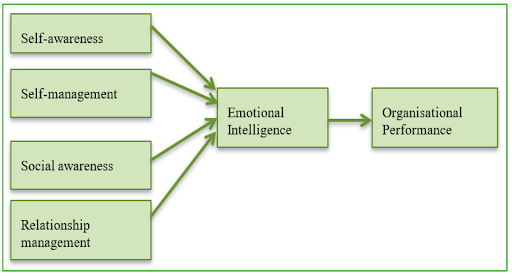
Figure 5: Traits, such as ‘self-awareness’, ‘self-management’, ‘social awareness’ and ‘relationship management’, lead to a stable and thriving level of emotional intelligence, which results in academic and organizational performance.
From “Impact of Emotional Intelligence on Organizational Performance: An Analysis in Malaysian Public Administration”, by Suganthi et al., 2021, MDPI, 11(3), p 5/22. https://doi.org/10.3390/admsci11030076. In the public domain.
6.2 Correlation Between EI and Cooperative Learning
In addition to the simple link between emotional intelligence and good grades, there has been a further correlation determined between EI and cooperative learning. According to the Cooperative Learning Institute, cooperative learning, also known as Project-Based Learning, is defined as the instructional use of small groups so that students work together to maximize their own and each other’s learning (Johnson, What is Cooperative Learning?, Cooperative Learning Institute). Cooperative learning usually takes place without a teacher or lectures and emphasizes the student’s ability to teach themselves through exercises, experiments, and projects, while also forming relationships. In a study performed by two universities in Madrid, Spain, 692 students were used to test this correlation. Before the study, each student’s Spanish language and mathematical abilities were tested. In addition, each student was asked to take an EI test, which measured emotional intelligence in various fields, some of which include stress management, adaptability, and general mood. For the study, the students were randomly split into two groups; the experimental group and the control group. For one full school year, the experimental group was taught solely through cooperative learning techniques, while the control group continued their classes normally, with teacher instruction. At the end of the year, all 692 students were tested once more on their abilities in language and math and were asked to retake the emotional intelligence test. The results saw that the experimental group, which had undergone cooperative learning, scored considerably higher on the content test than the control group. While it did not increase as much as the experimental group, the control group scores also slightly increased, which might be due to the fact that they were exposed to the experimental students and, hence, also adopted certain emotional intelligence traits. In addition, it was concluded that the post-study test in Spanish Language had better scores than the pre-study test. Overall, the students who had done cooperative learning throughout the year received noticeably higher results on the EI test, than the students who went about their normal manner of learning. While the results of the EI test seem to have been valid and connected to the correlation, the results in the different content tests might, nonetheless, not be entirely well-grounded. Over the summer, many students lose their learning rhythm and, when they finally come back to school, have to re-adjust to the classroom environment and schoolwork. Therefore, it is likely that the Spanish test was higher at the end of the year because the students were more accustomed and had learned more at that point, than at the beginning of the year. This study clearly showed the strong correlation between emotional intelligence and cooperative learning, since it directly measured the two factors and found a positive connection. Being able to quickly adapt to changes in one’s environment is an indicator of one’s measure of emotional intelligence. In a 2017 study on college students, it was concluded that more adaptable people have higher self-esteem and are less likely to experience burnout. This feature serves as a useful technique and can help, not only in scholarly situations, but also in real-life dilemmas.
6.3 Negative Relation Between Test Anxiety and Academic Performance
Nowadays, test anxiety is a very common occurrence in teenage students, worldwide. This type of anxiety may appear in various forms and can come as a result of various factors. According to the University of North Carolina at Chapel Hill, exam anxiety is defined as a combination of physical symptoms and emotional reactions that interfere with your ability to perform well on tests (Tips & Tools, Learning Center of UNC at Chapel Hill). Test anxiety is a type of performance anxiety, in which someone worries about how well they will perform, given their circumstances and the pressure put on them. As mentioned earlier, anxiety can result from many different reasons. One of the main stress triggers of exam anxiety is family and peer pressure, in addition to personal pressure focused on obtaining a high academic performance, which allows for a better future outlook.
6.31 Neurodivergent Disorders
While almost every person experiences this type of anxious behavior in their lives, frequent or continuous anxiety can be classified as a neurodivergent condition. A neurodivergent condition occurs when the brain malfunctions, and as a result, works and processes differently than a normal brain. Disorders, such as ADHD (Attention-Deficit Hyperactivity Disorder), Autism, Dyslexia, and Tourette’s Syndrome all fall under the term of neurodiversity. While anxiety is a commonly-diagnosed condition, it can strongly impact academic performance, and ultimately, one’s emotional intelligence. In this case, emotional intelligence means to identify and deal with emotions, so that they can be overcome and not stressed over. However, anxiety limits a person’s ability to control their emotions, and hence, might cause a person to have a lower level of emotional intelligence.
6.32 Impact and Solutions to Anxiety
In a 2020 study, performed by Spanish health research centers and psychology departments, it was concluded that exam anxiety is negatively related to academic performance, psychological well-being, social relations, and physical well-being. In contrast, exam anxiety has been positively related to stress, frustration, dropping out of school, and depression. Exam anxiety leads to very negative consequences and has a large impact on a student’s future, not only in school but also in a future career or relationships. However, to prevent such catastrophic situations in students’ lives, there are new alternatives or accommodations to test-taking. For example, in US high schools, students with psychological disorders or conditions are given extra time on exams, to prevent unnecessary stress. With this time alteration, students are allowed 1.5x to twice as much time as regular, non-accommodated students. In addition, the BTEC diploma (graduate certificate in US), allows university students to complete a degree in a shorter amount of time, with more focus on work-related qualifications, rather than academic qualifications. This form of diploma gives students the option to drift away from typical college content, to take more career-focused courses. Although there are some ways to fight test anxiety, it acts as a disadvantage to academic performance and decreases emotional intelligence in students.
6.4 Conclusion
In conclusion, academic pressure can have a large impact on academic performance and test/GPA results. As a consequence of this extreme academic stress, students do not build a proper level of emotional intelligence, which can lead them to face very difficult situations in life. If someone does not have emotional intelligence, it will be difficult for them to deal with stressful emotions in the future and they may not be able to control their emotions well. Therefore, it is important for students to learn, at a young age, how to positively manage their stress and build emotional intelligence, so that they can continue to succeed in school and university.
7. Neurodevelopmental/Neurodivergent Individuals and Emotional Intelligence
Until now, we have discussed several relationships between potential factors and variables that can impact one another. However, understanding the emotional experiences of individuals who are neurodivergent is essential for fostering inclusivity and support. Neurodivergency refers to a concept that recognises and celebrates the natural variations in neurological functioning among individuals. It encompasses conditions such as autism spectrum disorder (ASD), attention deficit hyperactivity disorder (ADHD), and other neurodevelopmental conditions. These individuals often have distinct cognitive and sensory profiles along with adhering to societal norms and expectations in terms of emotional expression and social interactions. that can differ significantly from the majority of the population, commonly referred to as neurotypical individuals.
7.1 ASD and ADHD
7.11 Autism Spectrum Disorder and Neural Mechanisms
Autism Spectrum Disorder (ASD) is a lifelong neurodevelopmental condition characterized by challenges in social interaction and communication and involves repetitive behavior patterns and alterations in brain regions like the hippocampus, cerebellum, and amygdala.
7.12 Attention Deficit Hyperactivity Disorder (ADHD) Neural Mechanisms
Attention Deficit Hyperactivity Disorder (ADHD) is a neurodevelopmental condition with constant inattention, hyperactivity, and impulsivity. It typically affects focus, impulse control, and daily functioning, combined with genetic and environmental factors.
7.2 Emotional Intelligence in Neurodivergent Population
7.21 Research Studies on Emotional Intelligence and ASD
Reynolds et al. (2018) found that the relationship between executive functioning and emotional intelligence was not statistically significant but children with ASD displayed deficits in interpersonal skills, intrapersonal skills, and overall emotional intelligence compared to neurotypical individuals. Furthermore, Boiley, Kingston, and Montgomery (2017) discovered that individuals with ASD showed weaknesses in both trait and ability emotional intelligence. Another study by Brady et al. (2014) revealed that both neurotypical and ASD young adults exhibited high average cognitive and intellectual abilities, while ASD individuals indicated lower levels of emotional intelligence relative to their typically-developing counterparts.
(See Reynolds, J. L., Lincoln, A. J., Iravani, R., Toma, V., & Brown, S. (2018) on the relationship between executive functioning and emotional intelligence in children with an autism spectrum disorder).
7.22 Research Studies on Emotional Intelligence and ADHD
Similarly, studies on emotional intelligence in ADHD have provided valuable insights. Laporta-Herrero and Latorre-Forcén (2020) observed that children and adolescents with ADHD presented lower scores in interpersonal skills, adaptability, and overall emotional intelligence. Additionally, Quintero et al. (2017) found that individuals with ADHD showed lower emotional intelligence development, with ADHD severity in childhood or adulthood not affecting current emotional intelligence.
7.23 Implications
In conclusion, research studies on emotional intelligence and neurodevelopmental disorders such as ASD and ADHD have consistently demonstrated deficits in emotional intelligence among individuals with these conditions. Both cases exhibit difficulties and display lower scores in interpersonal skills, adaptability, and overall emotional intelligence, emphasizing significant implications for understanding and addressing the emotional and social challenges faced by individuals with these conditions.
7.3 The Brain Structure of ADHD and ASD
7.31 Brain Structure in Individuals with Autism
Research conducted by Scheltz (2003) has clarified the intricate brain structure and its impact on social interactions significantly, indicating that individuals with deficits in neural circuits and face recognition areas, such as the amygdala, medial prefrontal cortices, and superior temporal gyrus, struggle to interpret social cues effectively. Adding on to that, several studies and MRI analyses have revealed that autistic individuals exhibit a smaller fusiform region in the inferior temporal cortex, responsible for object and facial expression recognition, inhibiting social perception and appropriate reactions, potentially compromising their ability to attend to relevant stimuli. Another significant discovery to consider is that individuals with autism often have an enlarged hippocampus and amygdala, potentially influencing the presence of anxiety and lack of emotional regulation (McDonald & Flanagan, 2004).
7.32 Brain Structure in Individuals with ADHD
In the case of ADHD, individuals also encounter social deficits. Research has shown that individuals with ADHD struggle to recognise their own emotions, engage emotionally with facial expressions, possess lower tolerance, and demonstrate limited self-control. This is due to the imbalance in neurotransmitters, mainly dopamine and noradrenaline, responsible for the brain’s reward centers, mood regulation, and impulse control. Moreover, the dysfunction both in the basal ganglia, responsible for impulsivity and decision-making, and the prefrontal cortex potentially can lead to a lack of control in emotional responses and behaviors (Campo et al., 2011).
7.4 Coping Strategies in ADHD and ASD
A comprehensive study by Dachez and Ndobo (2017) embarked on a qualitative exploration of coping strategies employed by adults with autism. Through self-constructed structured interviews, the researchers identified eight coping strategies utilized by these individuals: special interests, seeking support from atypical friends, militancy, diagnosis, seeking support from animals, normalization, intellectualization, and humor. Building upon this notion, Al-Yagon, Lachmi, and Shalev (2020) investigated the coping strategies of adults with ADHD with a particular focus on the mediating role of attachment patterns. The results uncovered that adults with ADHD displayed more maladaptive attachment and coping outcomes. This comprehensive understanding of coping mechanisms provides invaluable insights into the unique ways in which adults with autism and ADHD navigate the challenges they encounter. Finally, a significant study by Kaur and Katevarapu reveals differences between adolescents with ADHD and ASD. Adolescents with ADHD exhibit higher emotional intelligence and employ problem-focused and emotion-focused coping styles. In contrast, adolescents with ASD tend to rely more on avoidance-focused coping strategies. These compelling studies not only highlight the diverse coping strategies employed by individuals with ASD and ADHD but also emphasize the significance of adaptive coping skills in promoting resilience and well-being.
7.5 Coping Strategies in ADHD and ASD
According to Goleman’s model, emotional competencies, which are essential to emotional intelligence, are not natural talents but rather learned capabilities. Goleman emphasizes that these competencies can be developed and enhanced through dedicated effort and practice. Considering that emotional intelligence can be learned, acquired, and improved, it is believed that therapy and individualized Education for patients with ASD and ADHD can help them develop more emotional intelligence.
7.6 Conclusion
The exploration of emotional intelligence and its implications for individuals with neurodivergent disorders such as ASD and ADHD reveals significant deficits in emotional intelligence among these populations. Research consistently emphasizes the importance of addressing the emotional and social difficulties faced by individuals with these conditions. This section’s exploration of the general connection with emotional intelligence, brain structures, and coping strategies among individuals with ASD and ADHD highlights the significance of addressing their unique challenges, promoting inclusivity, support, and the development of emotional intelligence in individuals with these conditions.
8. Discussion & Conclusion
8.1 Review of Question
Emotional intelligence is defined as the ability to identify and positively comprehend one’s emotions and feelings, to optimally communicate with others, show empathy, and calmly resolve conflicts or stressful situations. In researching emotional intelligence, we posed the question of how this form of intelligence can affect academic pressure and a stressful school environment, in general.
8.2 Review of Focal Points
In response to our thought, it can be concluded that academic pressure has a large toll on emotional intelligence, as it can negatively impact certain psychological abilities, such as the control of emotions and the ability to form relationships and adapt to new surroundings. In addition, a lack of emotional intelligence can cause a degradation of oneself and lead students to become less confident and more fearful of failure. Academic pressure and stress can cause detrimental damage to school experiences but also lead to even more stressful situations in the future because an appropriate and compact level of emotional intelligence was never formed.
8.3 Practical Implementation of EI Training
Through our research, it has been clear that emotional intelligence is a crucial factor in a person’s success, at any stage of their lives. To continue developing successful human beings, current and future generations must step up to encourage and further emotional intelligence. We propose that emotional intelligence be practiced in the classroom, starting at a young age. Exercises, such as roleplays, reflections, and cooperative learning, can help children build up their level of emotional intelligence. As children get older, these interactive workshops could shift to real-life research and experiments on emotional intelligence. It is also important that teachers and officials strongly support and encourage their students, as this can play a large role in emotional intelligence, through building self-confidence and motivation. Even after graduating from school or university, this practice of emotional intelligence should continue to be observed, whether that be at home, independently, or in the workplace.
8.4 The Need for Further Research on the Relationship Between Academic Pressure and Emotional Intelligence
While there is certainly much evidence regarding the fact that academic pressure negatively correlates with emotional intelligence, there is still a tremendous amount of research that needs to be done, to solidify this conclusion. Factors, such as race, ethnicity, and sexual orientation all play roles in emotional intelligence since they are all vital ways in which people identify themselves. Apart from these outside factors, it is important to question how outside experiences and events (trauma, pain, happiness, achievements, etc.) impact emotional intelligence. These questions were obviously not included in our paper, since they have not been studied yet. Therefore, our paper is limited in information and we cannot properly conclude the correlation. Nonetheless, our paper offers a lot of information on emotional intelligence, making it possible for us to form a hypothesis on our questions.
8.5 Concluding Thoughts and Statements
Nowadays, many students struggle with academic pressure, especially in the age of technology and social media. According to the U.S. Department of Health and Human Services, it is concluded that one in five students experience mental health problems throughout their school career. In another study performed by the Cross River Therapy Program, it was deduced that 50% of middle school students and 75% of high school students reported feeling stressed over academics all the time. The struggle of academic stress is seen worldwide, across all ages, making it a major concern for both students, as well as parents, and teachers. As a result of these highly-stressful situations, some students seek to resolve their pain and exhaustion by committing suicide. These student deaths are tragic occurrences and affect many people in the school environment. In order to prevent higher suicide rates among students, it is important for students to learn how to deal with their emotions and feeling. Through the practice of emotional intelligence, we can only hope that future students will become successful and prospering adults, who are able to control themselves and feel self-motivated & confident.
References
Bar-On, R. (1997). BarOn emotional quotient inventory. Multi-health systems.
Blakemore, S. J., & Mills, K. L. (2014). Is adolescence a sensitive period for sociocultural processing? Annual Review of Psychology, 65, 187-207.
Estrada, M., Monferrer, D., Rodríguez, A., & Moliner, M. Á. (2021). Does emotional intelligence influence academic performance? The role of compassion and engagement in education for sustainable development. Sustainability, 13(4), 1-18.
Farina, E., Pepe, A., Ornaghi, V., & Cavioni, V. (2021). Trait Emotional Intelligence and School Burnout Discriminate Between High and Low Alexithymic Profiles: A Study With Female Adolescents. Frontiers in Psychology, 12, 1-11.
Freud, A. (1969). Adolescence as a developmental disturbance. Adolescence, 20(2), 5-14.
Geldhof, G. J., Bowers, E. P., & Lerner, R. M. (2013). Special section introduction: Thriving in context: Findings from the 4-H Study of Positive Youth Development. Journal of Youth and Adolescence, 42(1), 1-5.
Gentrup, S., Lorenz, G., Kristen, C., & Kogan, I. (2020). Self-fulfilling prophecies in the classroom: Teacher expectations, teacher feedback and student achievement. Learning and Instruction, 65, 1-17.
Gunnar, M. R., Wewerka, S., Frenn, K., Long, J. D., & Griggs, C. (2009). Developmental changes in hypothalamus-pituitary-adrenal activity over the transition to adolescence: Normative changes and associations with puberty. Development and Psychopathology, 21(1), 69-85.
Hogeveen, J., Salvi, C., & Grafman, J. (2016). ‘Emotional Intelligence’: Lessons from Lesions. Trends in Neurosciences, 39(10), 694-705.
MacCann, C., Jiang, Y., Brown, L. E. R., Double, K. S., Bucich, M., & Minbashian, A. (2020). Emotional intelligence predicts academic performance: A meta-analysis. Psychological Bulletin, 146(2), 150-186.
McCormick, C. M., Green, M. R., & Simone, J. J. (2016). Translational relevance of rodent models of hypothalamic-pituitary-adrenal function and stressors in adolescence. Neurobiology of Stress, 6, 31-43.
Moller, S., Stearns, E., Blau, J. R., & Land, K. C. (2006). Smooth and rough roads to academic achievement: Retention and race/class disparities in high school. Social Science Research, 35(4), 1034-1061.
Perry, N. B., Donzella, B., & Gunnar, M. R. (2022). Pubertal stress recalibration and later social and emotional adjustment among adolescents: The role of early life stress. Psychoneuroendocrinology, 135, 105578.
Petrides, K. V., & Furnham, A. (2001). Trait emotional intelligence: Psychometric investigation with reference to established trait taxonomies. European Journal of Personality, 15(6), 425-448.
Riley, T., & Ungerleider, C. (2012). Self-fulfilling prophecy: How teachers’ attributions, expectations, and stereotypes influence the learning opportunities afforded Aboriginal students. Canadian Journal of Education, 35(2), 303-333.
Rosenthal, R., & Jacobsen, L. (1968). Pygmalion in the classroom: Self-fulfilling prophecies and teacher expectations. The Urban Review, 3(1), 16-20.
Salovey, P., & Mayer, J. D. (1990). Emotional intelligence. Imagination, Cognition and Personality, 9(3), 185-211.
Shirazi, F., & Heidari, S. (2019). The relationship between critical thinking skills and learning styles and academic achievement of nursing students. Journal of Nursing Research, 27(4), 1-7.
Simos, D. S., Kokkinos, A., Tentolouris, N., Dimos Thanopoulos, C., Mantzou, E., Artemiadis, A., … & Nicolaides, N. C. (2019). Pythagorean self-awareness intervention: A novel cognitive stress management technique for body weight control. European Journal of Clinical Investigation, 49(10), 1-10.
Smith, A. E., Jussim, L., & Eccles, J. (1999). Do self-fulfilling prophecies accumulate, dissipate, or remain stable over time? Journal of Personality and Social Psychology, 77(3), 548–565.
Stinson, D. A., Cameron, J. J., Wood, J. V., Gaucher, D., & Holmes, J. G. (2009). Deconstructing the “reign of error”: Interpersonal warmth explains the self-fulfilling prophecy of anticipated acceptance. Personality and Social Psychology Bulletin, 35, 1165-1178.
Tabassum, D., & Akhter, N. (2020). Relationship between social competence and academic performance of university students.
Tao, V. Y. K., Li, Y., & Wu, A. M. S. (2022). Incremental intelligence mindset, fear of failure, and academic coping. Journal of Pacific Rim Psychology, 16, 1-12.
Taylor, R. D., Oberle, E., Durlak, J. A., & Weissberg, R. P. (2017). Promoting positive youth development through school-based social and emotional learning interventions: A meta-analysis of follow-up effects. Child Development, 88(4), 1156-1171.
University of Rochester Medical Center. (n.d.). Self-determination theory of motivation – Center for Community Health & Prevention. Retrieved from https://www.urmc.rochester.edu/community-health/patient-care/self-determination-theory.aspx
Wang, M.-T., & Fredricks, J. A. (2014). The reciprocal links between school engagement, youth problem behaviors, and school dropout during adolescence. Child Development, 85, 722-737. https://doi.org/10.1111/cdev.12138




